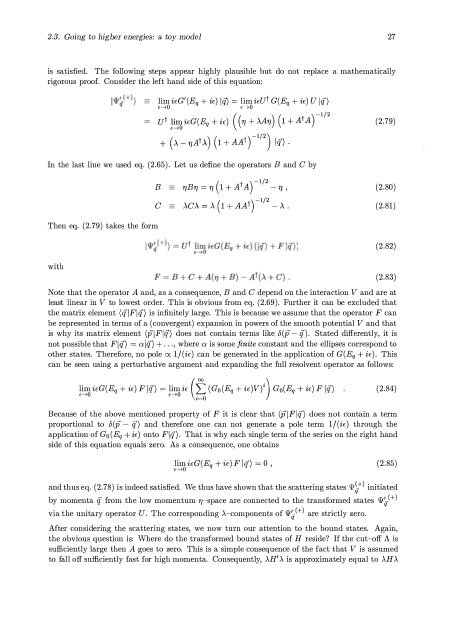The Nucleon-Nucleon Interaction in a Chiral Effective Field Theory
The Nucleon-Nucleon Interaction in a Chiral Effective Field Theory
The Nucleon-Nucleon Interaction in a Chiral Effective Field Theory
You also want an ePaper? Increase the reach of your titles
YUMPU automatically turns print PDFs into web optimized ePapers that Google loves.
2.3. Go<strong>in</strong>g to higher energies: a toy model 27<br />
is satisfied. <strong>The</strong> follow<strong>in</strong>g steps appear highly plausible but do not replace a mathematically<br />
rigorous proof. Consider the left hand side of this equation:<br />
lim iEG'(Eq + iE) Iv = lim iEUt G(Eq + iE) U Iq')<br />
€-+o €-+o<br />
Ut !� iEG(Eq +iE) ((77 + >'A77) (1 + AtA)- 1/2<br />
+ (>' - 77At>.) (1 + AAt) - 1/2 ) Icf) .<br />
In the last l<strong>in</strong>e we used eq. (2.65). Let us def<strong>in</strong>e the operators B and C by<br />
<strong>The</strong>n eq. (2.79) takes the form<br />
with<br />
B<br />
C<br />
( ) - 77B77 = 77 1 + At A 1/2 - 'TJ ,<br />
>'C>' = >. (1 + AAt) - 1/2 _ >. .<br />
(2.79)<br />
(2.80)<br />
(2.81)<br />
(2.82)<br />
(2.83)<br />
Note that the operator A and, as a consequence, B and C depend on the <strong>in</strong>teraction V and are at<br />
least l<strong>in</strong>ear <strong>in</strong> V to lowest order. This is obvious from eq. (2.69). Further it can be excluded that<br />
the matrix element (q'IFIq') is <strong>in</strong>f<strong>in</strong>itely large. This is because we ass urne that the operator F can<br />
be represented <strong>in</strong> terms of a (convergent) expansion <strong>in</strong> powers of the smooth potential V and that<br />
is why its matrix element (plFlcf) does not conta<strong>in</strong> terms like 8(p - cf). Stated differently, it is<br />
not possible that Flq') = alq') + ... , where a is some f<strong>in</strong>ite constant and the ellipses correspond to<br />
other states. <strong>The</strong>refore, no pole cx 1 j (iE) can be generated <strong>in</strong> the application of G (Eq + iE). This<br />
can be seen us<strong>in</strong>g a perturbative argument and expand<strong>in</strong>g the full resolvent operator as follows:<br />
lim itG(Eq + iE) F Icf) = lim iE (f (Go(Eq + iE)V)i) Go(Eq + iE) F Iq')<br />
(2.84)<br />
€-+o €-+o<br />
i=O<br />
Because of the above mentioned property of F it is clear that (p lFlq') does not conta<strong>in</strong> a term<br />
proportional to 8(p - cf) and therefore one can not generate a pole term 1j(iE) through the<br />
application of Go(Eq + iE) onto FIif). That is why each s<strong>in</strong>gle term of the series on the right hand<br />
side of this equation equals zero. As a consequence, one obta<strong>in</strong>s<br />
lim iEG(Eq + iE) F Iq') = 0 ,<br />
€-+o<br />
(2.85)<br />
and thus eq. (2.78) is <strong>in</strong>deed satisfied. We thus have shown that the scatter<strong>in</strong>g states \ji�+) <strong>in</strong>itiated<br />
by momenta cf from the low momentum 77-space are connected to the transformed states \ji:r(+)<br />
via the unitary operator U. <strong>The</strong> correspond<strong>in</strong>g >.-components of \ji:r(+) are strictly zero.<br />
After consider<strong>in</strong>g the scatter<strong>in</strong>g states, we now turn our attention to the bound states. Aga<strong>in</strong>,<br />
the obvious question is: Where do the transformed bound states of H reside? If the cut-off A is<br />
sufficiently large then A goes to zero. This is a simple consequence of the fact that V is assumed<br />
to fall off sufficiently fast for high momenta. Consequently, >.H' >. is approximately equal to >.H >.












